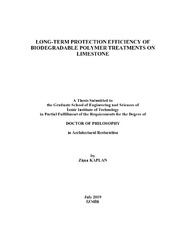Please use this identifier to cite or link to this item:
https://hdl.handle.net/11147/7464| Title: | Long-Term Protection Efficiency of Biodegradable Polymer Treatments on Limestone | Other Titles: | Bio Bozunur Polimerlerin Kireç Taşı Üzerindeki Uzun Süreli Koruma Etkisi | Authors: | Kaplan, Zişan | Advisors: | Böke, Hasan Sofuoğlu, Aysun İpekoğlu, Başak |
Keywords: | Historic preservation Biopolymers Limestones Conservation and restoration |
Publisher: | Izmir Institute of Technology | Source: | Kaplan, Z. (2019). Long-term protection efficiency of biodegradable polymer treatments on limestone. Unpublished doctoral dissertation, Izmir Institute of Technology, Izmir, Turkey | Abstract: | Synthetic polymers can be replaced by biodegradable ones as adhesive, water repellents and consolidants in stone conservation to preserve historic buildings from further deterioration. In this study, the long-term stabilities of two biodegradable polymers, polyhydroxybutyrate (PHB) and poly-l-lactide (PLA) and an acrylic polymer (Paraloid B72), which are commonly used in conservation works of artefacts, were evaluated on limestone through an UV lamp-weathering chamber. Chemical and morphological changes induced by accelerated weathering test were followed by Fourier Transform Infrared spectroscopy (FT-IR) and Scanning Electron Microscopy (SEM) analysis. The protection efficiencies of the polymers were determined by following the changes in the color, capillary water absorption and static contact angle on the limestone surfaces in accordance with CEN standards developed by the European Committee of Standardization (CEN) for conservation of cultural property. PHB, PLA and Paraloid B72 coatings significantly increased hydrophobicity, decreased capillary water absorption and caused negligible change in the color of the limestone. All polymers showed chemical, physical and optical changes under accelerated weathering conditions. Paraloid B72 decomposed by the reduction of molecular weight, decomposition of ester group and formation of gamma lactones and hydro peroxides. PHB and PLA decomposed with formation of CO2 and hydro peroxide, hydrolysis of ester groups and reduction of the molecular weight. Chemical changes cause to etching, holes, voids, cracks and slight color differentiations on the coatings by chain scission, breaking of polymer bonds and formation of volatile gaseous products. Protection efficiencies of the PLA and PHB polymers almost same as that of the widely used acrylic polymer Paraloid B72. However, PLA and PHB seem to be promising polymers as protective agents due to their reversibility and biodegradability, low chromatic changes, good hydrophobic behavior and good stability to weathering in reducing the effects of outdoor exposure on limestone surfaces. Bio bozunur polimerler, tarihi yapıları bozulmalara karşı korumak için taş korumada yapıştırıcı, su itici ve birleştirici olarak kullanılan sentetik polimerlere alternatif olabilirler. Bu çalışmada, iki bio bozunur polimerin, polihidroksibütirat (PHB) ve poli-l-laktidin (PLA) ve tarihi eserlerin korunmasında yaygın olarak kullanılan bir akrilik polimerin (Paraloid B72) uzun vadeli dayanıklılıkları UV-lambalı-yaşlandırma test cihazında, kireçtaşları üzerinde değerlendirilmiştir. Hızlandırılmış yaşlandırma testi sonucunda oluşan kimyasal ve morfolojik değişiklikler, Fourier Dönüşümlü Kızılötesi spektroskopisi (FT-IR) ve Taramalı Elektron Mikroskobu (SEM) analizleri ile izlemiştir. Polimerlerin koruma etkinlikleri, kültürel mirasın korunması için Avrupa Standardizasyon Komitesi (CEN) tarafından geliştirilen CEN standartlarına uygun olarak kireçtaşı yüzeylerinde renk, kılcal su emilimi, statik temas açısı ve su buharı geçirgenliğindeki değişiklikler izlenerek belirlenmiştir. PHB, PLA ve Paraloid B72 kaplamalarının; kireç taşının hidrofobikliğini önemli ölçüde arttırdığı, kılcal su emilimini azalttığı ve kireçtaşı renginde önemli bir değişikliğe neden olmadığı tespit edilmiştir. Tüm polimerler, hızlandırılmış yaşlandırma koşulları altında kimyasal, fiziksel ve optik değişiklikler göstermiştir. Paraloid B72, moleküler ağırlığın azalması, ester grubunun ayrışması ve gama laktonlarının ve hidro peroksitlerin oluşumu ile bozulmuştur. PHB ve PLA ise CO2 ve hidro peroksit oluşumu, ester gruplarının hidrolizi ve moleküler ağırlığın azalması ile bozulmuştur. Kimyasal değişiklikler, zincir kırılması, polimer bağlarının kırılması ve uçucu gaz ürünlerinin oluşumu ile kaplamalarda aşınmaya, deliklere, boşluklara, çatlaklara ve hafif renk farklılaşmalarına neden olmuştur. PLA ve PHB polimerlerinin koruma etkinlikleri, yaygın olarak kullanılan akrilik polimer Paraloid B72 ile aynıdır. Bununla birlikte, PLA ve PHB'nin, geri dönüştürülebilirliği, biyolojik olarak parçalanabilirliği, düşük kromatik değişimleri, iyi hidrofobik davranışları ve dış hava koşullarına maruz kalan kireç taşı yüzeyindeki dayanıklılıklarının iyi olması nedeniyle koruyucu maddeler olarak ümit verici oldukları görülmüştür. |
Description: | Thesis (Doctoral)--Izmir Institute of Technology, Architectural Restoration, Izmir, 2019 Includes bibliographical references (leaves: 78-89) Text in English; Abstract: Turkish and English |
URI: | https://hdl.handle.net/11147/7464 |
| Appears in Collections: | Phd Degree / Doktora |
Files in This Item:
| File | Description | Size | Format | |
|---|---|---|---|---|
| T002058.pdf | DoctoralThesis | 14.74 MB | Adobe PDF |  View/Open |
CORE Recommender
Page view(s)
356
checked on Jul 7, 2025
Download(s)
392
checked on Jul 7, 2025
Google ScholarTM
Check
Items in GCRIS Repository are protected by copyright, with all rights reserved, unless otherwise indicated.